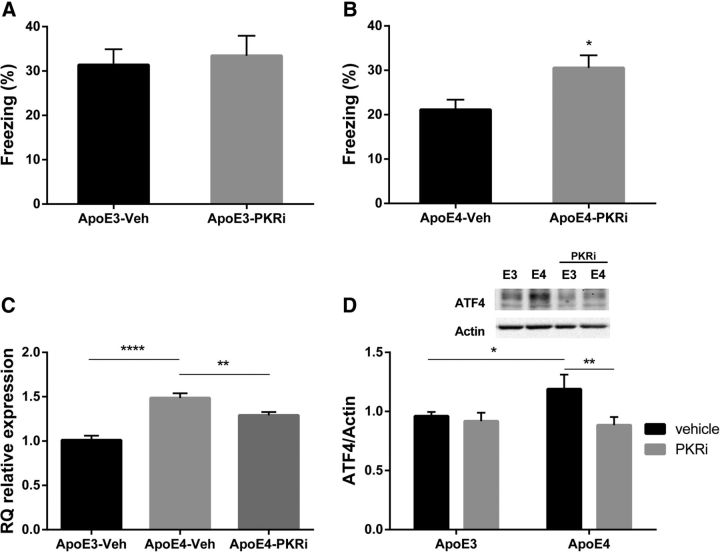Figure 3.
PKR inhibition rescues memory impairment in ApoE4 mice and reduces ATF4 mRNA and protein levels in the hippocampus. ApoE4 and ApoE3 (4–5 months) mice were injected intraperitoneally with a PKRi (n = 15) or vehicle (n = 16–22), at a dose of 0.335 μg/g body weight, 1 h before conditioning in a weak contextual fear conditioning paradigm, in two separate experiments for each strain. A, ApoE3-treated mice do not differ significantly from ApoE3 vehicle (p = 0.72), in the context test 1 week after training. B, ApoE4 PKR-injected mice show significant increase in the freezing levels compared with ApoE4 vehicle. *p = 0.01. C, ApoE4 mice were injected intraperitoneally with PKRi (n = 7), and their hippocampus was harvested 3 h after injection for evaluation of ATF4 mRNA levels. For control, ApoE4 (n = 7) and ApoE3 (n = 8) were injected with vehicle. In addition to increased mRNA expression in ApoE4 hippocampus compared with ApoE3 (****p < 0.0001), PKRi significantly reduced mRNA levels in ApoE4-treated group compared with ApoE4 vehicle (**p = 0.007). D, ApoE4 vehicle hippocampal slices express higher ATF4-protein levels compared with ApoE3 vehicle slices (ApoE4-veh, n = 18; ApoE3-veh, n = 20). *p = 0.04. PKRi decreases protein levels of ATF4 in ApoE4 hippocampal slices compared with ApoE4 vehicle slices (ApoE4-PKRi, n = 19). **p = 0.009. Data are mean RQ/Mean ± ΔCt/SEM. *p < 0.05. **p < 0.01. ***p < 0.001. A, B, t test. C, One-way ANOVA with LSD post hoc comparisons. D, Two-way ANOVA with Fisher's LSD pairwise comparisons.

